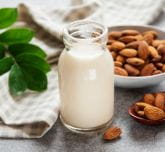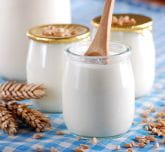The worldwide dairy product market
The consumption of dairy products in all their forms - butter, cream, yoghurt, cheese, ice cream , etc – was for many years buoyant in Western countries. Today, these countries have slowed down their consumption whilst the worldwide market is driven by emerging markets which are increasingly attracted to them.
According to the International Dairy Federation (IDF), the worldwide consumption of dairy products grew by 2.5% in 2018, mainly thanks to regions such as Southeast Asia, where milk was until recently not a true part of the local food culture.
In these countries as well as in India, the consumption of dairy products is growing by 5 to 6% per year! By comparison, it is only rising by 1.5% and 1% in the USA and in the countries of the European Union, which are nonetheless big consumers of dairy products. In Latin America, this growth is stronger: from 2 to 3% per year.
This does not mean however that Western countries have abandoned dairy products. The demand for butter, for example, remains very high in these countries, with the United States and Canada leading the way, and in the European Union. This product is frequently used by the majority of consumers in their daily diets. Butter can be consumed fresh, but also used as a fat to cook with and make cakes and pastries.
However, world butter prices remain relatively high. Therefore, this product is not consumed everywhere in the same proportions. Imports have even dropped off in certain countries such as Algeria and Ivory Coast. On the other hand, they continue to increase in virtually all Asian countries, as reported by France AgriMer in its 2018 review of the dairy market.
Asia appears to be more partial to the world cheese offering. Japan has substantially increased its consumption of cheese in recent years: an exponential trend purportedly linked with recent reports on the health benefits offered by cheese.
Camembert, for example, is said to help “prevent dementia” and blue cheese is said to have a “rejuvenating effect on blood vessels”, reports France AgriMer. To meet its domestic demand, Japan has bought extensively from the European Union, the leading worldwide exporter of cheese.
The consumption of dairy products in France
French people consume a lot of dairy products. Milk, butter, cream, yoghurt and cheese are all part of their everyday diet. However, due to average prices rising - in all segments except dairy desserts where prices have remained relatively stable - French consumption of dairy products has slightly dropped.
To replace these, plant-based alternatives, whilst still being a niche product, are displaying healthy growth. These products have become direct competitors to milk, cream and fresh dairy products (yoghurts, etc.). Between 2015 and 2018, households doubled their annual purchases of plant-based products, according to France AgriMer.
France, a cheese country
Renowned the world over for its huge variety of cheeses, France is also well known for eating a lot of cheese products.
Whilst cow’s milk cheese is the most consumed in France, its sales slightly fell in 2018 (-1.7%), having increased in 2016 and flattened off in 2017.
But not all cow’s milk cheeses have followed this trend: sales of mozzarella remain buoyant, for example, and raclette cheese continues to perform well. It is mainly soft cheeses such as camembert and coulommiers that found less favour with consumers last year.
Goats cheese, meanwhile, is doing quite well in France. Households bought 0.8% more in 2018 than in 2017, and in particular matured “logs” (bûchettes), whose sales increased by 5.8% over the period. It should be said that the goats cheese log is a mainstay product, accounting for 56.6% of purchases of goat’s cheese sold in France.
The French are also very keen on sheep milk cheese: home consumption grew by 0.5% in 2018, having already risen strongly by 5.6% in 2017. A large share of this consumption is concentrated around fresh cheeses such as feta. Indeed, their sales account for 22.5% of household purchases of ewe’s milk cheese and are up by 10.7% in the space of a year, according to France AgriMer.
On the other hand, Roquefort is becoming less popular. French consumers bought less of this cheese in quantity: approximately -1.4% in 2018, compared with 2017. On average, only 46.9% of households bought Roquefort at least once in the year.
Milk and butter
The French appear however to be gradually moving away from cow’s milk (excluding organic), in which sales are declining: -3.4% in 2017, then -5.8% in 2018, according to Kantar Worldpanel. “This is truly a strong and sustained trend, which is accompanied by a reduction in production: the flagship product of this family, standard semi-skimmed UHT milk, is particularly affected, and masks the growth in consumption of certain specific milks (flavoured, added vitamins, lactose-free),” observes France AgriMer.
Sales of butter also dropped by 5.8% in 2018, probably due to significant price rises (+14.9% on average over the year). Consumers appear to have preferred substitutes such as low-fat spreads, where sales grew by 1.6%.
Yoghurt, desserts and creams
Sales are also sluggish in the yoghurt and dairy desserts department, down by 3.3% and 3.6% respectively on an annual basis. This strong trend is continuously reaffirmed year after year, in spite of the many innovations in the sector.
Creams are less affected by this decline, although they also saw their sales drop by 0.2% in 2018. The category was bogged down mainly by fresh cream and aerosol “squirty” cream, whereas purchases of long life cream increased.
Dairy at SIAL Paris
Whether they offer milk, butter, yoghurt, desserts, creams, cheese or any other type of cheese speciality, exhibitors from the dairy sector literally flock to SIAL Paris.
In 2022, there were 480 of them - including 84% from outside France. Among them, the French firms Savencia Fromage & Dairy and Lactalis International, but also the Dutch companies Friesland-Campina and Interfood Holding BV, the Italians Granarolo Spa and Consorzio del Formaggio Parmigiano Reggiano and the Greek firm Delta Foods SA.
All these dairy professionals see SIAL as a unique opportunity to both reach a wide audience - benefiting from the event’s media coverage and its international reach - and discover or showcase the latest innovations in their sector.
Your dedicated sales representative:



Other sectors presented at SIAL

INSPIRING FOOD BUSINESS WORLDWIDE
- Food & Drinks Malaysia - Kuala Lumpur
- SIAL Canada - Montreal
- SIAL Canada - Toronto
- SIAL Paris - Paris
- SIAL in China - Shanghai
- SIAL in China - Shenzhen
- SIAL in India - New Delhi
- SIAL Interfood - Jakarta
- TuttoPizza - Shanghai
- TuttoPizza - Napoli
- Gourmet Selection - Paris
- Cheese & Dairy products show - Paris
- Djazagro - Algiers









